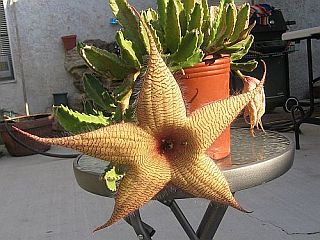 As promised, this is the bloom of Stapelia gigantea, also known as the carrion plant. You can see pollinators crawling on it near the center of the flower when you click to enlarge this picture.
As promised, this is the bloom of Stapelia gigantea, also known as the carrion plant. You can see pollinators crawling on it near the center of the flower when you click to enlarge this picture.
As one can surmise from the name, the flowers don’t smell particularly pleasant. They lure flies to do their pollinating for them, and they do this with a number of ingenious adaptations. The surface of the flowers is covered by fine “hair” and the overall color is flesh-toned. The color of the center of the flower is a deep red, like a wound, which is what flies would normally be attracted to on a carcass. Then, of course, there’s the smell. It really is putrid, and so convincing that flies even lay their eggs on it, although when the maggots hatch, they starve to death, since there really isn’t a cadaver there for their nourishment.
The carrion flower has a number of other common names, as creative as it is strange. It is called Zulu giant, hairy starfish flower, star cactus and starfish cactus. These last two names are misleading since this is not a cactus at all, but the blossoms do resemble starfish.
The Stapelia gigantea is considered an invasive plant in Hawaii and a weed in Australia.

